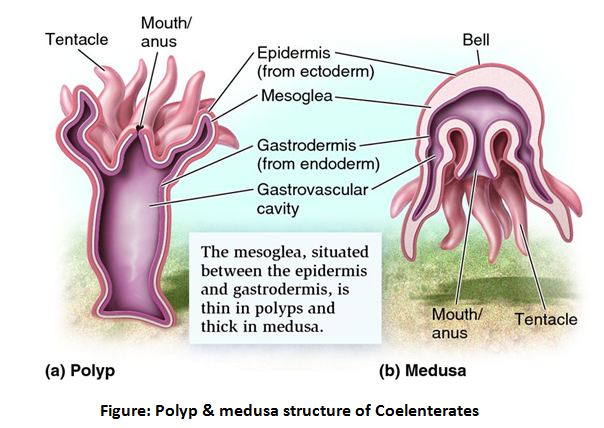Coelenterata is all about beauty of nature. Let’s study; where they stand biologically
One of the most important and marking topics of biology is biological classification. In it, you have to learn about each and every phylum specifically.  The probability of getting questions from biological classification in medical entrance exam is quite high.
One of the interesting and important phyla is Coelenterata. It comes under the category of invertebrates of Kingdom animals. Yes! I am going to tell you good information of this phylum.
Phylum Coelenterata (Cnidaria) include aquatic, marine, sessile or free living organisms.  This Phylum includes approximately 9000 species. Cnidarians are animals; it was proved by Peyssonal (1723) & Trembel (1744)
Why name Cnidaria? It is because of the name of cnidoblasts or cnidocytes which are present in the tentacles of the body. Cnidocytes constitute the defense body of coelenterates. It also helps in capturing the prey.
Now let’s study about certain features of this phylum.
- They have tissue level of organization.
- They are diploblastic except few. Epidermis is the external body layer. Gastroderm is formed from internal germ layer which is endoderm.
- They possess radial symmetry.
- Digestive cavity is known as gastro-vascular cavity. Digestive system is incomplete. Here, incomplete means it consisted of single opening which act as anus and mouth both.
- Tentacles are present near the mouth.
- No special system for excretion & respiration is present.
- Both sexual & asexual types of reproduction occur.
- Body’s components include polyp & medusa (Figure).
- They show alternation of generation
- In some species, polyp or medusa is absent.
Confused about polyp & medusa? Hnn? Not an issue! let me tell you this too.
Polyp –
- They are fixed & rarely free.
- Their body is cylindrical with a stalk (Hydra)
- Velum (bordering membrane) is absent.
- Sense organs are also absent.
- Gonads absent.
- Asexual reproduction occurs by budding.
- Radial & circular canals are absent in gastro vascular cavity.
Medusa-
- They are free swimming & are present in open water.
- They have umbrella like body with reduced stalk structure.
- Velum is present
- Sense organs (tentacles) are present.
- On radial canals, four gonads are present
- Sexual reproduction occurs.
- Stomach, four radial canals. One circular canal is present in gastro vascular cavity.
 Let me tell you now, the categorization of Phylum Cnidarian. It is classified into 3 classes.  Here let’s take a look.
- Hydrozoa –
- The dominant part of their body is polyp & it is formed by budding. Medusa may also be present.
- They are multi cellular diploblastic animals
- Polymorphic tendency is present.
- Gonads are also observed in hydrozoa.
- They have 6 orders. Viz. Hydroidea, Trachylina, Hydrocorallina, chondrophora, Pteromedusae & siphonophora.
- Some of the examples are obelia, hydra, Physalia, Porpita etc
- Scyphozoa –
- They are present in medusoid
- Tentaculocysts act as tentacles.
- Gonads are endodermal by origin.
- Stomach & 4 gastric pouches are present in gastro-vascular system.
- Class Scyphozoa include 5 orders viz. Stauromedusae, Coronatae, Cubomedusae, Discomedusae (semeastomeae), Rhyzostomeae.
- Some of the examples are jelly fish, Lucernaria, Pilema, Rhizostoma, Aurelia etc.
- Anthrozoa –
- They possess only polyp form.
- Nematocysts (cnidoblast) are present.
- Gonads are endodermal in origin.
- It is categorized into two subclasses. Viz. 1. Hexocorallia (7 orders) & 2. Octacorallia (6 orders).
- Some of the examples are fungia, brain corals. Black corals, tubipora etc.
Words don’t end here. There is still a lot of information left to tell. For grasping that information, you can click over this link.
And yes! In case of any doubt, post it to this link.
Your all queries will be answered by use at its earliest 🙂
Well! I am Anjali Ahuja, Biology educator, a part of askIITians family. We always try to aid students in their study. We have created interesting study material which can make your study quite easy.  Yes! Click over this link & grab it fast.
- Excited
- Fascinated
- Amused
- Bored
- Sad
- Angry




